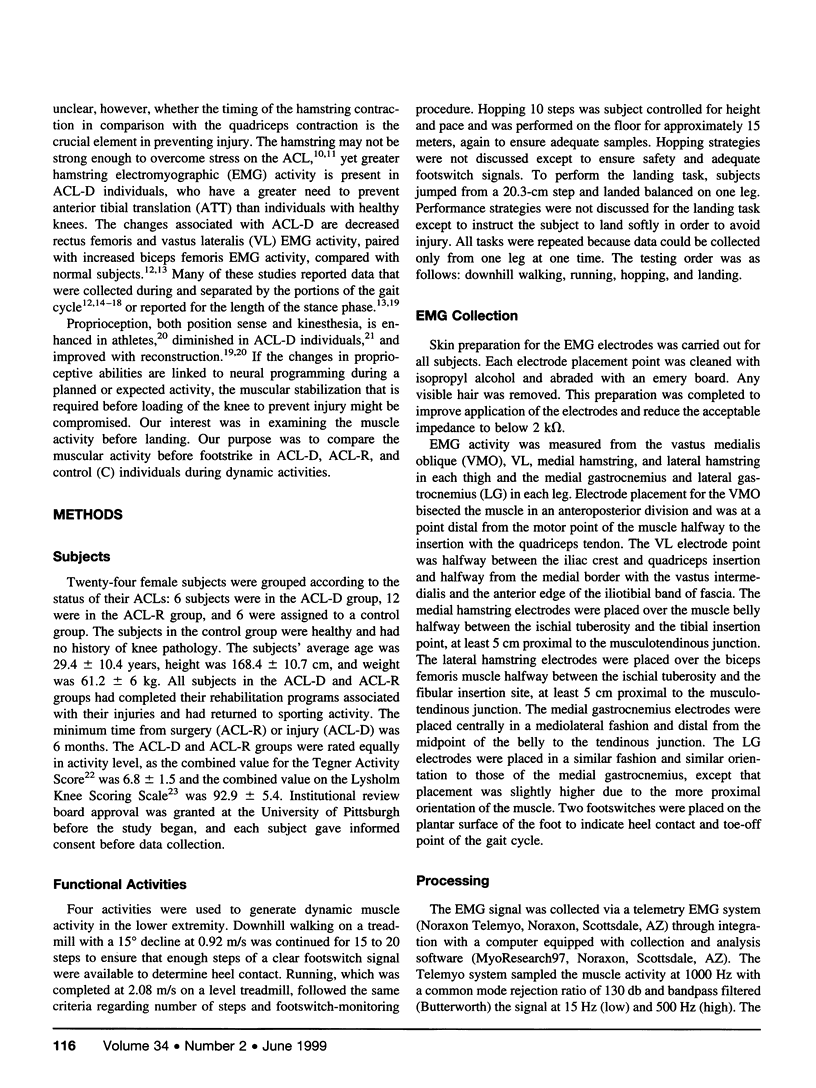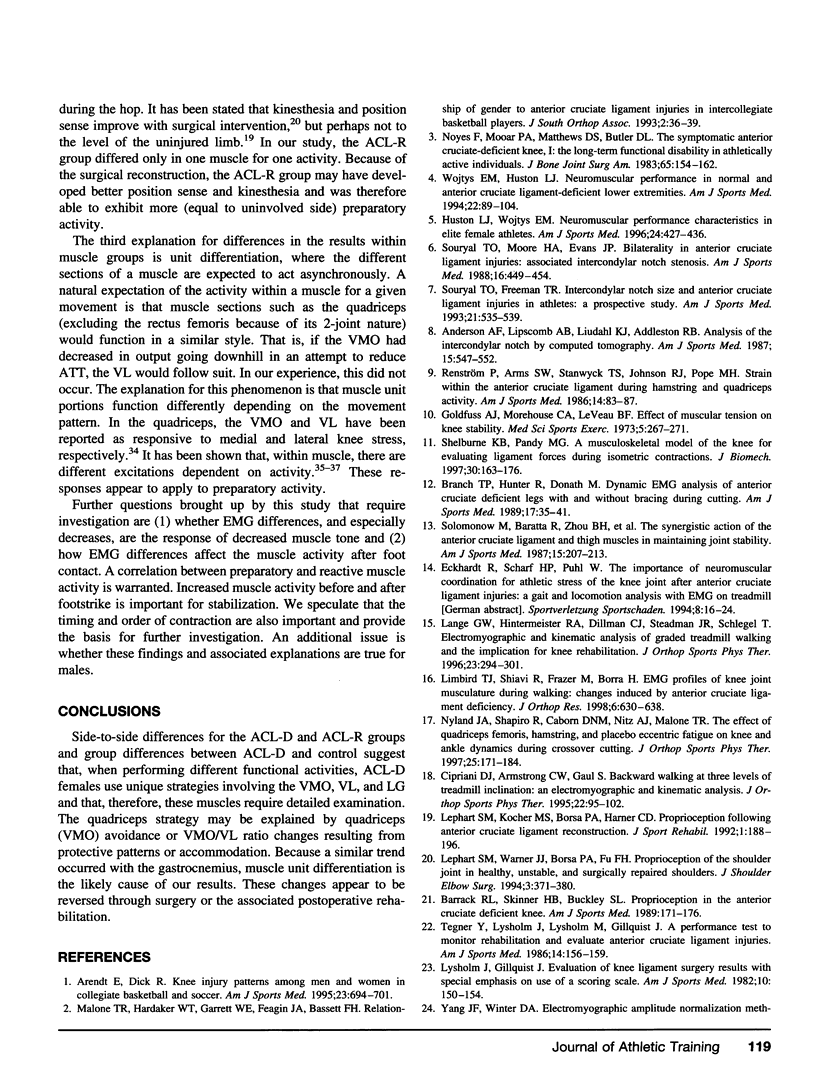Abstract
Objective:
Underlying the ability of the hamstrings to decrease tibial anterior shear is the time of firing in comparison with the quadriceps. This timing may be aided by neural programming during a planned or expected activity. It is theorized that individuals who have better programming ability will suffer fewer anterior cruciate ligament (ACL) injuries due to joint protection through muscular stabilization. A component of this dynamic restraint is the development of muscular tension before the knee is loaded. The objective of our study was to compare the muscular activity before footstrike in ACL-deficient (ACL-D), ACL-reconstructed (ACL-R), and control (C) females during functional activities.
Design and Setting:
Active females were divided into groups based on their ACL status. The study was conducted in a neuromuscular research laboratory.
Subjects:
Twenty-four female subjects (ACL-D = 6, ACL-R = 12, C = 6).
Measurements:
Integrated electromyographic (IEMG) activity from the thigh (vastus medialis obliquus [VMO], vastus lateralis [VL], medial hamstring, and lateral hamstring) and leg (medial gastrocnemius and lateral gastrocnemius [LG]) and footswitch signals were recorded during downhill walking (15° at 0.92 m/s), running (2.08 m/s), hopping, and landing from a step (20.3 cm). IEMG activity was normalized to the mean amplitude of the sample and analyzed for area and mean amplitude for 150 milliseconds before heelstrike. Side-to-side differences were determined by t tests, and separate one-way analyses of variance (ANOVA) were used to detect differences among the 3 groups for each muscle of each activity.
Results:
IEMG area side-to-side differences for the ACL-D group appeared in the LG (involved [I] = 36.4 ± 19.7, uninvolved [U] = 60.1 ± 23.6) during landing, in the VMO (I = 11.4 ± 3.8, U = 7.2 ± 3.1) and VL (I = 13.3 ± 2.7, U = 8.9 ± 1.9) during running, and in the VMO (I = 9.2 ± 4.2, U = 19.5 ± 7.3) during downhill walking. IEMG mean amplitude side-to-side differences for the ACL-D group appeared in the LG (I = 79.7 ± 30.3, U = 122.3 ± 34.9) during downhill walking and in the VMO (I = 78.6 ± 23.2, U = 45.8 ± 18.9) during the run; IEMG mean amplitude side-to-side differences for the ACL-R group appeared in the LG (I = 74.7 ± 40.0, U = 52.8 ± 14.3) during the hop. The ACL-D group had higher IEMG means than control in the VL (ACL-D = 12.9 ± 5.8, C = 7.1 ± 3.9), but lower in the VMO (ACL-D = 9.2 ± 4.2, C = 15.7 ± 3.6).
Conclusions:
The side-to-side differences of the ACL-D and ACL-R groups, as well as the group differences between ACL-D and control, suggest that different muscle activation strategies are used by females when performing different dynamic activities. Therefore, muscle unit differentiation may be the cause of our results. These changes appear to be reversed through surgery or the associated postoperative rehabilitation.
Keywords: closed kinetic chain, preparation, muscle, activation
Full text
PDF





Images in this article
Selected References
These references are in PubMed. This may not be the complete list of references from this article.
- Anderson A. F., Lipscomb A. B., Liudahl K. J., Addlestone R. B. Analysis of the intercondylar notch by computed tomography. Am J Sports Med. 1987 Nov-Dec;15(6):547–552. doi: 10.1177/036354658701500605. [DOI] [PubMed] [Google Scholar]
- Arendt E., Dick R. Knee injury patterns among men and women in collegiate basketball and soccer. NCAA data and review of literature. Am J Sports Med. 1995 Nov-Dec;23(6):694–701. doi: 10.1177/036354659502300611. [DOI] [PubMed] [Google Scholar]
- Branch T. P., Hunter R., Donath M. Dynamic EMG analysis of anterior cruciate deficient legs with and without bracing during cutting. Am J Sports Med. 1989 Jan-Feb;17(1):35–41. doi: 10.1177/036354658901700106. [DOI] [PubMed] [Google Scholar]
- Buchanan T. S., Kim A. W., Lloyd D. G. Selective muscle activation following rapid varus/valgus perturbations at the knee. Med Sci Sports Exerc. 1996 Jul;28(7):870–876. doi: 10.1097/00005768-199607000-00014. [DOI] [PubMed] [Google Scholar]
- Ciccotti M. G., Kerlan R. K., Perry J., Pink M. An electromyographic analysis of the knee during functional activities. II. The anterior cruciate ligament-deficient and -reconstructed profiles. Am J Sports Med. 1994 Sep-Oct;22(5):651–658. doi: 10.1177/036354659402200513. [DOI] [PubMed] [Google Scholar]
- Cipriani D. J., Armstrong C. W., Gaul S. Backward walking at three levels of treadmill inclination: an electromyographic and kinematic analysis. J Orthop Sports Phys Ther. 1995 Sep;22(3):95–102. doi: 10.2519/jospt.1995.22.3.95. [DOI] [PubMed] [Google Scholar]
- Collins J. J., O'Connor J. J. Muscle-ligament interactions at the knee during walking. Proc Inst Mech Eng H. 1991;205(1):11–18. doi: 10.1243/PIME_PROC_1991_205_256_02. [DOI] [PubMed] [Google Scholar]
- Eckhardt R., Scharf H. P., Puhl W. Die Bedeutung der neuromuskulären Koordination für die sportliche Belastbarkeit des Kniegelenkes nach vorderen Kreuzbandverletzungen. Eine Gang- und Laufanalyse mittels EMG auf dem Laufband. Sportverletz Sportschaden. 1994 Mar;8(1):16–24. doi: 10.1055/s-2007-993448. [DOI] [PubMed] [Google Scholar]
- Escamilla R. F., Fleisig G. S., Zheng N., Barrentine S. W., Wilk K. E., Andrews J. R. Biomechanics of the knee during closed kinetic chain and open kinetic chain exercises. Med Sci Sports Exerc. 1998 Apr;30(4):556–569. doi: 10.1097/00005768-199804000-00014. [DOI] [PubMed] [Google Scholar]
- Goldfuss A. J., Morehouse C. A., LeVeau B. F. Effect of muscular tension on knee stability. Med Sci Sports. 1973 Winter;5(4):267–271. [PubMed] [Google Scholar]
- Huston L. J., Wojtys E. M. Neuromuscular performance characteristics in elite female athletes. Am J Sports Med. 1996 Jul-Aug;24(4):427–436. doi: 10.1177/036354659602400405. [DOI] [PubMed] [Google Scholar]
- Kuster M., Wood G. A., Sakurai S., Blatter G. 1994 Nicola Cerulli Young Researchers Award. Downhill walking: a stressful task for the anterior cruciate ligament? A biomechanical study with clinical implications. Knee Surg Sports Traumatol Arthrosc. 1994;2(1):2–7. doi: 10.1007/BF01552646. [DOI] [PubMed] [Google Scholar]
- Lange G. W., Hintermeister R. A., Schlegel T., Dillman C. J., Steadman J. R. Electromyographic and kinematic analysis of graded treadmill walking and the implications for knee rehabilitation. J Orthop Sports Phys Ther. 1996 May;23(5):294–301. doi: 10.2519/jospt.1996.23.5.294. [DOI] [PubMed] [Google Scholar]
- Lass P., Kaalund S., leFevre S., Arendt-Nielsen L., Sinkjaer T., Simonsen O. Muscle coordination following rupture of the anterior cruciate ligament. Electromyographic studies of 14 patients. Acta Orthop Scand. 1991 Feb;62(1):9–14. doi: 10.3109/17453679108993083. [DOI] [PubMed] [Google Scholar]
- Limbird T. J., Shiavi R., Frazer M., Borra H. EMG profiles of knee joint musculature during walking: changes induced by anterior cruciate ligament deficiency. J Orthop Res. 1988;6(5):630–638. doi: 10.1002/jor.1100060503. [DOI] [PubMed] [Google Scholar]
- Lutz G. E., Palmitier R. A., An K. N., Chao E. Y. Comparison of tibiofemoral joint forces during open-kinetic-chain and closed-kinetic-chain exercises. J Bone Joint Surg Am. 1993 May;75(5):732–739. doi: 10.2106/00004623-199305000-00014. [DOI] [PubMed] [Google Scholar]
- Lysholm J., Gillquist J. Evaluation of knee ligament surgery results with special emphasis on use of a scoring scale. Am J Sports Med. 1982 May-Jun;10(3):150–154. doi: 10.1177/036354658201000306. [DOI] [PubMed] [Google Scholar]
- McNair P. J., Marshall R. N. Landing characteristics in subjects with normal and anterior cruciate ligament deficient knee joints. Arch Phys Med Rehabil. 1994 May;75(5):584–589. [PubMed] [Google Scholar]
- Noyes F. R., Mooar P. A., Matthews D. S., Butler D. L. The symptomatic anterior cruciate-deficient knee. Part I: the long-term functional disability in athletically active individuals. J Bone Joint Surg Am. 1983 Feb;65(2):154–162. doi: 10.2106/00004623-198365020-00003. [DOI] [PubMed] [Google Scholar]
- Nyland J. A., Shapiro R., Caborn D. N., Nitz A. J., Malone T. R. The effect of quadriceps femoris, hamstring, and placebo eccentric fatigue on knee and ankle dynamics during crossover cutting. J Orthop Sports Phys Ther. 1997 Mar;25(3):171–184. doi: 10.2519/jospt.1997.25.3.171. [DOI] [PubMed] [Google Scholar]
- Osternig L. R., Caster B. L., James C. R. Contralateral hamstring (biceps femoris) coactivation patterns and anterior cruciate ligament dysfunction. Med Sci Sports Exerc. 1995 Jun;27(6):805–808. [PubMed] [Google Scholar]
- Renström P., Arms S. W., Stanwyck T. S., Johnson R. J., Pope M. H. Strain within the anterior cruciate ligament during hamstring and quadriceps activity. Am J Sports Med. 1986 Jan-Feb;14(1):83–87. doi: 10.1177/036354658601400114. [DOI] [PubMed] [Google Scholar]
- Shelburne K. B., Pandy M. G. A musculoskeletal model of the knee for evaluating ligament forces during isometric contractions. J Biomech. 1997 Feb;30(2):163–176. doi: 10.1016/s0021-9290(96)00119-4. [DOI] [PubMed] [Google Scholar]
- Solomonow M., Baratta R., Zhou B. H., Shoji H., Bose W., Beck C., D'Ambrosia R. The synergistic action of the anterior cruciate ligament and thigh muscles in maintaining joint stability. Am J Sports Med. 1987 May-Jun;15(3):207–213. doi: 10.1177/036354658701500302. [DOI] [PubMed] [Google Scholar]
- Souryal T. O., Freeman T. R. Intercondylar notch size and anterior cruciate ligament injuries in athletes. A prospective study. Am J Sports Med. 1993 Jul-Aug;21(4):535–539. doi: 10.1177/036354659302100410. [DOI] [PubMed] [Google Scholar]
- Souryal T. O., Moore H. A., Evans J. P. Bilaterality in anterior cruciate ligament injuries: associated intercondylar notch stenosis. Am J Sports Med. 1988 Sep-Oct;16(5):449–454. doi: 10.1177/036354658801600504. [DOI] [PubMed] [Google Scholar]
- Tamaki H., Kitada K., Akamine T., Sakou T., Kurata H. Electromyogram patterns during plantarflexions at various angular velocities and knee angles in human triceps surae muscles. Eur J Appl Physiol Occup Physiol. 1997;75(1):1–6. doi: 10.1007/s004210050118. [DOI] [PubMed] [Google Scholar]
- Tegner Y., Lysholm J., Lysholm M., Gillquist J. A performance test to monitor rehabilitation and evaluate anterior cruciate ligament injuries. Am J Sports Med. 1986 Mar-Apr;14(2):156–159. doi: 10.1177/036354658601400212. [DOI] [PubMed] [Google Scholar]
- Tibone J. E., Antich T. J. Electromyographic analysis of the anterior cruciate ligament-deficient knee. Clin Orthop Relat Res. 1993 Mar;(288):35–39. [PubMed] [Google Scholar]
- Wojtys E. M., Huston L. J. Neuromuscular performance in normal and anterior cruciate ligament-deficient lower extremities. Am J Sports Med. 1994 Jan-Feb;22(1):89–104. doi: 10.1177/036354659402200116. [DOI] [PubMed] [Google Scholar]
- Wolf S. L., Ammerman J., Jann B. Organization of responses in human lateral gastrocnemius muscle to specified body perturbations. J Electromyogr Kinesiol. 1998 Feb;8(1):11–21. doi: 10.1016/s1050-6411(97)00001-1. [DOI] [PubMed] [Google Scholar]
- Yang J. F., Winter D. A. Electromyographic amplitude normalization methods: improving their sensitivity as diagnostic tools in gait analysis. Arch Phys Med Rehabil. 1984 Sep;65(9):517–521. [PubMed] [Google Scholar]





